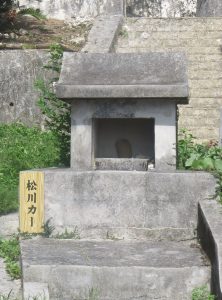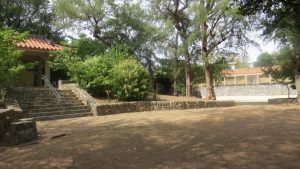A district connected to karate, Uebaru
Shuri, Naha and Tomari are districts regarded as the original cradle of karate. Yet, many other regions in Okinawa have their own martial art tales. Among these districts is Uebaru in Naha City.
Uebaru is located in between the Monorail Akamine Station and the Kaigungo Navy Headquarters Park, situated not far from the Okinawa Karate Kaikan. The area is famous for Shicha nu utaki (1) about which is written as follows.
“This area is nicknamed Machigā. In Oroku, this is where reconstruction started after the war. Many people came to live here. Right next to it can be found Machigā no Utaki. In the book ‘Ryūkyū Koku Yurai Ki’ (2), the name of the village Matsugawa (pronounced Machigā) is mentioned but no Utaki by the name of Matsugawa appears. However, looking in the list of Den (3), Machigā no Utaki is mentioned. In this case, it seems that the residence of the Matsugawa hamlet’s lord and the utaki became one.
 (Machigā)
(Machigā)
In some cases, a lord’s residence means only a ‘nā’ or garden, a place where festivals are held. Since there is an utaki there, sacred palm family plants called Māni have been planted in the area. This manifests the holy aspect of the site.
A long time ago in Uebaru, there were a lot of bushi. These bushi practiced karate every evening in this area. Bushi of Okinawa are different from bushi of Mainland Japan as here it means men with mighty physical strength.”
According to a deceased venerable man, “In Uebaru there existed an undulating slope called Nana kēn biragwā (4). A long time ago, Uebaru gave birth to a great amount of martial art experts, and along the way that became an issue. Therefore, the said slope was improved. After the land amelioration, no more bushi were born in Uebaru”.(5)
The site where the bushi trained is now a public park by the name of Takamaehara Park.
 (Shicha nu utaki)
(Shicha nu utaki)
On the Sunday that follows the lunar calendar June 25th (6), the Uebaru tug of war is held. In 2017, this Sunday falls on August 20th. While many tugs of war in Okinawa are soul-stirring and brawl-like events, the tug of war of Uebaru is a simple and elegant one. It is a festival to express gratitude for the rice plant harvest.
Tours in the district can be organized by local residents. If interested, please contact the Okinawa Karate Information Center.
Footnotes:
- Utaki means a sacred site or grove. In that case, the name could be translated by “lower sacred site”.
- It is said that the first Ryūkyū Kingdom official records were compiled in early 1700.
- Den most likely refers to Dunchi, or nobles or lords’ residences.
- Kēn most likely refers to the measure unit for 1,8 m. Therefore, Nana kēn may mean 12,6 m.
- Although there is no explanation in the text, having such a slope in the area might mean that locals had the opportunity to train their legs and hips by running which is essential in karate training.
- Roku gatsu kashichī or June kashichī is a rice plant harvest festival, a traditional event held according to the lunar calendar. Held on June 25th, rice cooked with fresh rice is presented as offerings to the hi-nu-kan, the god of fire and the family altar.
* The address of the park is 2-5 Takara, Naha City
Sources:
Work field on the history of Oroku (Naha City Oroku south public hall, 1993)
Naha Folk tale document (Naha City Board of Education, 1984)
